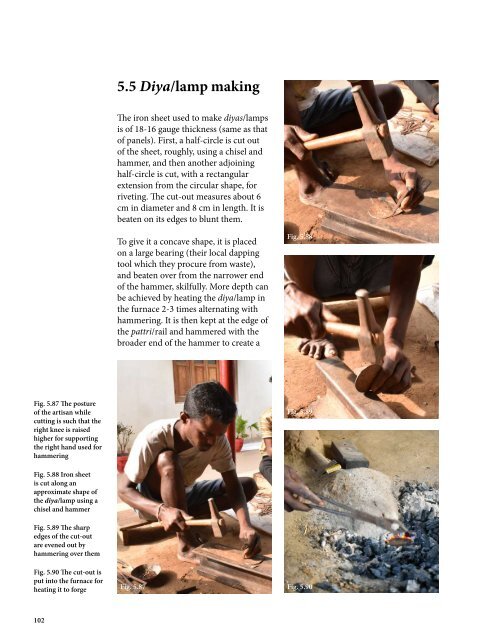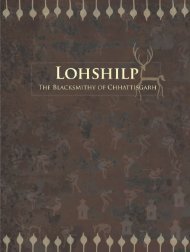CRAFT DOC_compressed
You also want an ePaper? Increase the reach of your titles
YUMPU automatically turns print PDFs into web optimized ePapers that Google loves.
5.5 Diya/lamp making<br />
The iron sheet used to make diyas/lamps<br />
is of 18-16 gauge thickness (same as that<br />
of panels). First, a half-circle is cut out<br />
of the sheet, roughly, using a chisel and<br />
hammer, and then another adjoining<br />
half-circle is cut, with a rectangular<br />
extension from the circular shape, for<br />
riveting. The cut-out measures about 6<br />
cm in diameter and 8 cm in length. It is<br />
beaten on its edges to blunt them.<br />
To give it a concave shape, it is placed<br />
on a large bearing (their local dapping<br />
tool which they procure from waste),<br />
and beaten over from the narrower end<br />
of the hammer, skilfully. More depth can<br />
be achieved by heating the diya/lamp in<br />
the furnace 2-3 times alternating with<br />
hammering. It is then kept at the edge of<br />
the pattri/rail and hammered with the<br />
broader end of the hammer to create a<br />
Fig. 5.88<br />
Fig. 5.87 The posture<br />
of the artisan while<br />
cutting is such that the<br />
right knee is raised<br />
higher for supporting<br />
the right hand used for<br />
hammering<br />
Fig. 5.89<br />
Fig. 5.88 Iron sheet<br />
is cut along an<br />
approximate shape of<br />
the diya/lamp using a<br />
chisel and hammer<br />
Fig. 5.89 The sharp<br />
edges of the cut-out<br />
are evened out by<br />
hammering over them<br />
Fig. 5.90 The cut-out is<br />
put into the furnace for<br />
heating it to forge Fig. 5.87<br />
Fig. 5.90<br />
102




